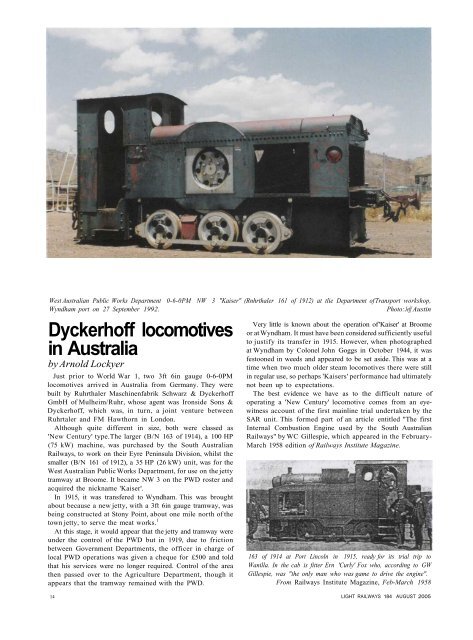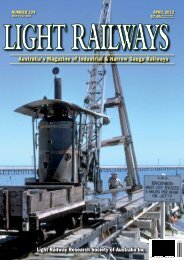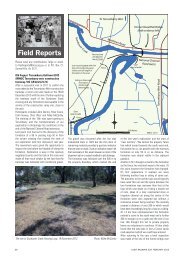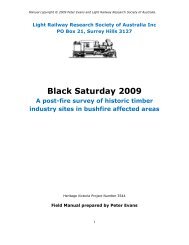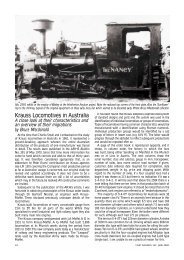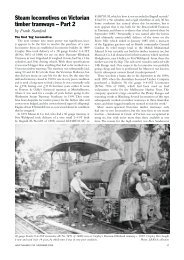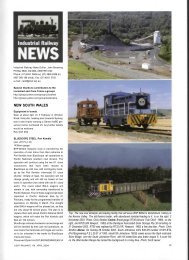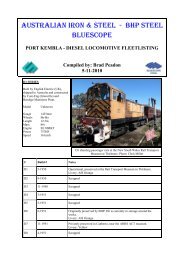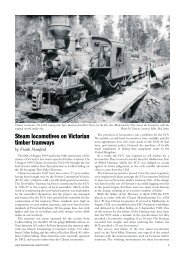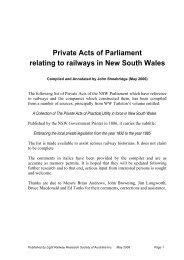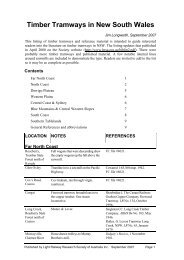Dyckerhoff locomotives in Australia - Light Railway Research ...
Dyckerhoff locomotives in Australia - Light Railway Research ...
Dyckerhoff locomotives in Australia - Light Railway Research ...
Create successful ePaper yourself
Turn your PDF publications into a flip-book with our unique Google optimized e-Paper software.
West <strong>Australia</strong>n Public Works Department 0-6-0PM NW 3 "Kaiser" (Rnhrthaler 161 of 1912) at tlie Department of Transport workshop,<br />
Wyndham port on 27 September 1992.<br />
Photo: Jeff Aust<strong>in</strong><br />
<strong>Dyckerhoff</strong> <strong>locomotives</strong><br />
<strong>in</strong> <strong>Australia</strong><br />
by Arnold Lockyer<br />
Just prior to World War 1, two 3ft 6<strong>in</strong> gauge 0-6-0PM<br />
<strong>locomotives</strong> arrived <strong>in</strong> <strong>Australia</strong> from Germany. They were<br />
built by Ruhrthaler Masch<strong>in</strong>enfabrik Schwarz & <strong>Dyckerhoff</strong><br />
GmbH of Mulheim/Ruhr, whose agent was Ironside Sons &<br />
<strong>Dyckerhoff</strong>, which was, <strong>in</strong> turn, a jo<strong>in</strong>t venture between<br />
Ruhrtaler and FM Hawthorn <strong>in</strong> London.<br />
Although quite different <strong>in</strong> size, both were classed as<br />
'New Century' type.The larger (B/N 163 of 1914), a 100 HP<br />
(75 kW) mach<strong>in</strong>e, was purchased by the South <strong>Australia</strong>n<br />
<strong>Railway</strong>s, to work on their Eyre Pen<strong>in</strong>sula Division, whilst the<br />
smaller (B/N 161 of 1912), a 35 HP (26 kW) unit, was for the<br />
West <strong>Australia</strong>n Public Works Department, for use on the jetty<br />
tramway at Broome. It became NW 3 on the PWD roster and<br />
acquired the nickname 'Kaiser'.<br />
In 1915, it was transfered to Wyndham. This was brought<br />
about because a new jetty, with a 3ft 6<strong>in</strong> gauge tramway, was<br />
be<strong>in</strong>g constructed at Stony Po<strong>in</strong>t, about one mile north of the<br />
town jetty, to serve the meat works. 1<br />
At this stage, it would appear that the jetty and tramway were<br />
under the control of the PWD but <strong>in</strong> 1919, due to friction<br />
between Government Departments, the officer <strong>in</strong> charge of<br />
local PWD operations was given a cheque for £500 and told<br />
that his services were no longer required. Control of the area<br />
then passed over to the Agriculture Department, though it<br />
appears that the tramway rema<strong>in</strong>ed with the PWD.<br />
Very little is known about the operation of 'Kaiser' at Broome<br />
or at Wyndham. It must have been considered sufficiently useful<br />
to justify its transfer <strong>in</strong> 1915. However, when photographed<br />
at Wyndham by Colonel John Goggs <strong>in</strong> October 1944, it was<br />
festooned <strong>in</strong> weeds and appeared to be set aside. This was at a<br />
time when two much older steam <strong>locomotives</strong> there were still<br />
<strong>in</strong> regular use, so perhaps 'Kaisers' performance had ultimately<br />
not been up to expectations.<br />
The best evidence we have as to the difficult nature of<br />
operat<strong>in</strong>g a 'New Century' locomotive comes from an eyewitness<br />
account of the first ma<strong>in</strong>l<strong>in</strong>e trial undertaken by the<br />
SAR unit. This formed part of an article entitled "The first<br />
Internal Combustion Eng<strong>in</strong>e used by the South <strong>Australia</strong>n<br />
<strong>Railway</strong>s" by WC Gillespie, which appeared <strong>in</strong> the February-<br />
March 1958 edition of <strong>Railway</strong>s Institute Magaz<strong>in</strong>e.<br />
163 of 1914 at Port L<strong>in</strong>coln <strong>in</strong> 1915, ready for its trial trip to<br />
Wanilla. In the cab is fitter Ern 'Curly' Fox who, accord<strong>in</strong>g to GW<br />
Gillespie, was "the only man who was game to drive the eng<strong>in</strong>e".<br />
From <strong>Railway</strong>s Institute Magaz<strong>in</strong>e, Feb-March 1958<br />
14 LIGHT RAILWAYS 184 AUGUST 2005
161 be<strong>in</strong>g tested at the works prior to despatch to Western <strong>Australia</strong>,<br />
as seen <strong>in</strong> an early catalogue published by FM Hawthorn "Sole<br />
Agent for Great Brita<strong>in</strong> & Colonies". John Brown<strong>in</strong>g Collection<br />
"Designed to work on l<strong>in</strong>es where water was scarce, it might have<br />
saved water but unfortunately it used nearly as much kerosene 2 as<br />
the average [steam] eng<strong>in</strong>e uses water. The driv<strong>in</strong>g power consisted of<br />
two cyl<strong>in</strong>ders placed horizontally and, when the eng<strong>in</strong>e was work<strong>in</strong>g,<br />
the vibration was terrific. The transmission was by means of a clutch<br />
worked by a hand wheel which had to be turned about ten times to<br />
put the eng<strong>in</strong>e <strong>in</strong>to neutral. By the time the driver had engaged the<br />
clutch, started the eng<strong>in</strong>e mov<strong>in</strong>g, and declutched aga<strong>in</strong>, the eng<strong>in</strong>e<br />
had moved a m<strong>in</strong>imum distance of approximately ten yards.<br />
For this reason the eng<strong>in</strong>e was useless for ord<strong>in</strong>ary yard shunt<strong>in</strong>g,<br />
as the only way it could be coupled to another vehicle with safety was<br />
to stop the eng<strong>in</strong>e short and push the vehicle on to it. After a few trials<br />
<strong>in</strong> the Port L<strong>in</strong>coln yard, the eng<strong>in</strong>e was parked <strong>in</strong> the Loco sheds<br />
and practically forgotten.<br />
However, early <strong>in</strong> 1915 it was decided by the authorities that a<br />
trial trip was to be made as far as Wanilla, a reduc<strong>in</strong>g station 24<br />
miles away from Port L<strong>in</strong>coln. A tra<strong>in</strong> was made up consist<strong>in</strong>g of two<br />
bolsters of rails and a blue brake [van], total weight 58 tons. A start<br />
was made about 9 am one morn<strong>in</strong>g when there was no other tra<strong>in</strong><br />
on the track. [Fitter/ Curly Fox was driv<strong>in</strong>g, accompanied by an<br />
expert from the firm who had supplied the eng<strong>in</strong>e. Eric Herbst was<br />
the guard and the writer was sent out as an observer, armed with a<br />
large turnip watch and a note book.<br />
The first four miles out of Port L<strong>in</strong>coln, which is mostly uphill,<br />
was carved out <strong>in</strong> the even time of one hour, but the next mile, which<br />
was all downhill, took only four m<strong>in</strong>utes. This was the fastest the<br />
eng<strong>in</strong>e ever travelled under its own power. Coomunga, 14 miles from<br />
Port L<strong>in</strong>coln, was reached <strong>in</strong> just under four hours. After a short spell to<br />
report progress to Port L<strong>in</strong>coln, where everyone was gett<strong>in</strong>g anxious,<br />
a start was made for the next sid<strong>in</strong>g, Pearlah.As the tra<strong>in</strong> was started<br />
the eng<strong>in</strong>e jumped nearly afoot <strong>in</strong> the air and stopped. An exam<strong>in</strong>ation<br />
disclosed that the expert, who was driv<strong>in</strong>g at the time, had started<br />
the eng<strong>in</strong>e <strong>in</strong> top gear. A fresh start was made , but we had not gone<br />
far when the eng<strong>in</strong>e developed a hot box on the front driv<strong>in</strong>g axle.<br />
This was cooled down [and] a fresh start made, but the bear<strong>in</strong>g was<br />
red hot before we had gone a hundred yards. As it looked as though<br />
we could not go on, we decided to return to Coomunga, detach the<br />
load<strong>in</strong>g and go home.<br />
Accord<strong>in</strong>gly, the tra<strong>in</strong> struggled back to Coomunga, the load<strong>in</strong>g<br />
was put off, the axle cooled down aga<strong>in</strong> and a start made for Port<br />
L<strong>in</strong>coln. About 6 pm, we had reached Duck Ponds, and still had<br />
nearly eight miles to go. As our prospects of reach<strong>in</strong>g home under our<br />
own steam appeared to be very poor, the tra<strong>in</strong> (what was left of it)<br />
was pushed <strong>in</strong>to the sid<strong>in</strong>g and a request was made by telephone, to<br />
Port L<strong>in</strong>coln, for an eng<strong>in</strong>e, which was duly sent out and we were<br />
hauled home, arriv<strong>in</strong>g just twelve hours after we had left.<br />
It was afterwards ascerta<strong>in</strong>ed that the driv<strong>in</strong>g axle of the combustion<br />
eng<strong>in</strong>e was badly bent. The eng<strong>in</strong>e did not run aga<strong>in</strong>, but was cased up<br />
and sent back to Isl<strong>in</strong>gton, where I believe it ended its days provid<strong>in</strong>g<br />
power for mach<strong>in</strong>ery <strong>in</strong> the workshops. "<br />
General arrangement draw<strong>in</strong>g of 163, show<strong>in</strong>g the two horizontal<br />
cyl<strong>in</strong>ders, as well as the flywheels, drive gears and the troublesome<br />
handwheel-operated clutch.<br />
John Brown<strong>in</strong>g Collection<br />
'Kaiser' was more fortunate. After many years of disuse, and<br />
several years on display <strong>in</strong> a park at Kununurra, it was brought<br />
back to Wyndham, to be preserved <strong>in</strong> company with its old<br />
stablemate Hudswell Clarke 0-6-0ST PRESTON (379 of 1891). 3<br />
'Kaiser' may not have fulfilled its maker's hopes and expectations,<br />
but it was a worthwhile attempt to <strong>in</strong>troduce a new<br />
and different type of motive power, one that would ultimately<br />
triumph - though not for a few decades. Today, it provides<br />
us with a fasc<strong>in</strong>at<strong>in</strong>g l<strong>in</strong>k to the pioneer<strong>in</strong>g days of <strong>in</strong>ternal<br />
combustion <strong>locomotives</strong>.<br />
161, 'Kaiser', at Wyndham <strong>in</strong> October 1944. Photo:John Goggs<br />
LIGHT RAILWAYS 184 AUGUST 2005<br />
Notes<br />
1. See "North West Coastal Tramways: Wyndham" by Ian Crellm and Frank<br />
Stamford, <strong>in</strong> <strong>Light</strong> <strong>Railway</strong>s 59, January 1978.<br />
2. The fuel used was most likely 'power kerosene', which is a mixture of<br />
kerosene and m<strong>in</strong>eral turps, often used <strong>in</strong> petrol eng<strong>in</strong>es of the period.<br />
3. See <strong>Light</strong> <strong>Railway</strong>s 151, February 2000, page 31.<br />
15


